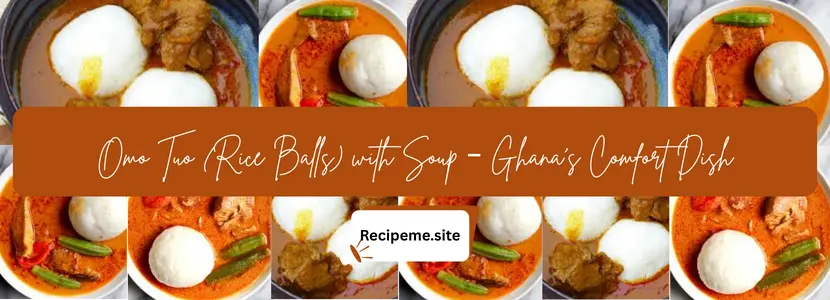
Introduction
What food do you turn to when you need comfort, warmth, and satisfaction in one meal? For many Ghanaians, the answer is simple: Omo Tuo (Rice Balls with Soup).Soft, smooth, and slightly sticky rice molded into balls, paired with rich Ghanaian soups like groundnut soup, palm nut soup, or light soup—it’s the ultimate comfort food. Growing up, Omo Tuo was the kind of dish that made Sundays feel special. The aroma of simmering soup filling the house was a signal that family mealtime was about to be unforgettable.
But what makes this dish so iconic, and why does it hold such a special place in Ghanaian cuisine? Let’s explore the journey of Omo Tuo from tradition to modern dining tables.
History of Omo Tuo
The name Omo Tuo originates from the Akan language and translates to “rice balls.” Historically, rice was not the primary staple for most Ghanaian communities, as yam, cassava, and maize dominated diets. However, with the increased cultivation and availability of rice in West Africa, it slowly became a key ingredient in local dishes.
Omo Tuo evolved as a softer, molded version of rice—designed to pair perfectly with hearty Ghanaian soups. It became especially popular during Sunday meals and festive gatherings, where families would prepare large pots of soup to serve with smooth rice balls.
Did You Know? In Northern Ghana, rice-based dishes like Omo Tuo are often preferred over fufu due to rice being more widely cultivated in that region.
Essential Ingredients for Omo Tuo
Making Omo Tuo is simple, but precision matters. The secret lies in achieving the perfect balance of softness and stickiness so the rice balls hold their shape.
For the Rice Balls (Omo Tuo):
-
3 cups of rice (preferably Jasmine or long-grain rice)
-
6–7 cups of water
-
Salt (optional)
For the Soup (commonly paired with Omo Tuo):
-
Chicken, goat, beef, or fish
-
Tomatoes, onions, garlic, and ginger
-
Peppers (scotch bonnet or chili)
-
Palm nut, groundnut (peanut butter), or light soup base
-
Seasoning cubes and salt
Variations of Omo Tuo
One of the reasons Omo Tuo is beloved is its versatility—it can be paired with many Ghanaian soups. Some popular variations include:
-
Omo Tuo with Groundnut Soup (Nkate Nkwan): Creamy peanut-based soup with tender meat.
-
Omo Tuo with Palm Nut Soup (Abenkwan): Rich, red-hued soup from palm nut extract.
-
Omo Tuo with Light Soup: A spicy, tomato-based broth, often served with goat meat or fish.
-
Omo Tuo with Vegetable Soup: A lighter, modern twist, often prepared with garden eggs and okra.
Preparation: Step-by-Step Guide
Here’s how you can make authentic Omo Tuo at home.
Ingredients for 4 servings:
-
2 cups of rice
-
4–5 cups water
-
A pinch of salt
Instructions for Rice Balls:
-
Cook the Rice
-
Wash rice thoroughly and add to a pot with water. Bring to boil.
-
-
Simmer Until Soft
-
Lower the heat and cook until rice becomes very soft, almost mushy. Stir occasionally to prevent burning.
-
-
Mash the Rice
-
Use a wooden spoon to mash the rice, breaking the grains until it forms a sticky, dough-like texture.
-
-
Mold into Balls
-
Wet your hands with clean water, scoop portions of rice, and shape them into smooth, round balls.
-
-
Serve Hot
-
Place the rice balls in a bowl and pair with your favorite Ghanaian soup.
-
Pro Tip: Jasmine rice is ideal for Omo Tuo because it becomes naturally soft and sticky after cooking.
Cultural Significance of Omo Tuo
Omo Tuo holds deep cultural significance in Ghana:
-
Sunday Tradition: Many households prepare Omo Tuo with groundnut or palm nut soup for Sunday lunch.
-
Celebrations: It is a common dish at weddings, funerals, and festive gatherings.
-
Unity: Sharing a large pot of soup with rice balls brings families and communities together.
It is often considered a symbol of warmth, generosity, and Ghanaian hospitality.
Serving Suggestions
Omo Tuo is versatile and can be paired with several soups. Common serving options include:
-
With groundnut soup for a creamy, nutty flavor.
-
With light soup for a spicy and tangy experience.
-
With palm nut soup for a hearty and traditional option.
-
With fish or chicken for added richness.
Did You Know? In Ghana, Omo Tuo is usually served hot, but in some modern restaurants, chefs add a twist by shaping smaller rice balls for appetizers.
Types of Omo Tuo
While the rice ball preparation is fairly standard, the type of soup served alongside creates different “types” of Omo Tuo meals. Some households even experiment with:
-
Brown Rice Omo Tuo: A healthier twist using brown rice.
-
Herbed Omo Tuo: Infusing the rice with herbs like parsley or bay leaves for extra aroma.
-
Mini Omo Tuo: Bite-sized balls served as finger food at events.
Tips for Making Perfect Omo Tuo
-
Use enough water to ensure the rice becomes very soft.
-
Stir frequently to avoid burning at the bottom of the pot.
-
Always mold the rice while hot for smooth, round shapes.
-
Serve immediately with hot soup for the best experience.
-
For extra flavor, cook rice with a little stock instead of plain water.
Other Valuable Insights
-
Nutritional Value: Omo Tuo is filling, providing carbohydrates for energy. Pairing with protein-rich soups balances the meal.
-
Hidden Fact: In some communities, Omo Tuo was traditionally eaten with hands instead of spoons, symbolizing closeness to the food.
-
Expert Tip: When cooking for large gatherings, prepare the soup a day before—its flavors deepen overnight.
Personal Experience: My First Encounter with Omo Tuo
I vividly remember my first encounter with Omo Tuo. It was during a visit to my grandmother’s home in Kumasi. She prepared steaming hot rice balls served with groundnut soup and goat meat. At first, I was unsure about the sticky texture, but after the first bite, I was hooked. The creamy soup blended perfectly with the soft rice, creating a comfort I hadn’t experienced before.
Today, Omo Tuo is not just food for me—it’s a memory of family, warmth, and tradition.
Conclusion
Omo Tuo (Rice Balls with Soup) is more than a dish; it’s a cultural treasure of Ghana. From its simple preparation to its versatility with different soups, it continues to unite families and communities. Whether served on a quiet Sunday afternoon or at a large celebration, Omo Tuo remains a symbol of comfort and tradition.
Frequently Asked Questions (FAQs)
1. What is Omo Tuo made of?
It is made of soft-cooked rice, mashed and molded into smooth balls, served with Ghanaian soups.
2. What type of rice is best for Omo Tuo?
Jasmine rice or long-grain rice works best because they become soft and sticky when cooked.
3. Which soups go well with Omo Tuo?
Groundnut soup, palm nut soup, light soup, and vegetable soups are common pairings.
4. Can Omo Tuo be made in advance?
Yes, but it’s best served fresh. If stored, keep in an airtight container and reheat with steam to maintain texture.
5. Is Omo Tuo healthy?
Yes, especially when paired with protein-rich soups. Using brown rice makes it even healthier.
6. Why is Omo Tuo considered a Sunday meal in Ghana?
Because it’s often reserved for special family gatherings and enjoyed with hearty soups, making Sundays the perfect time for it.
